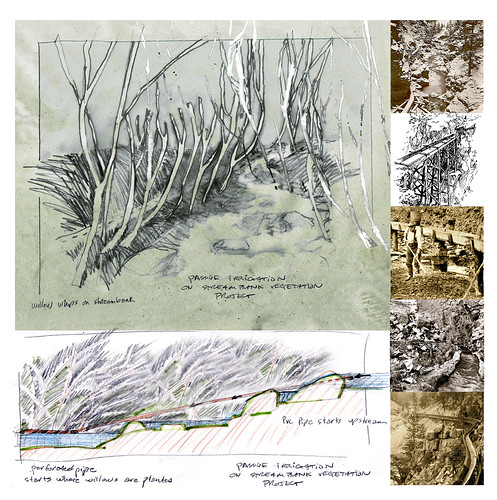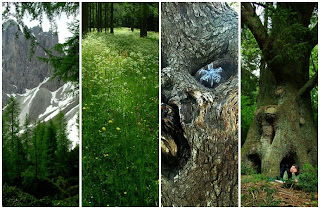Irrigating newly planted willows along creekbed
At a creekside cabin out in the mountains, we want more privacy from the road. A creek flows between the cabin and the road (see photo and description below) We have planted willow whips on the road-side of the creek by cutting wands (or whips) from the existing willows, dipping the ends in rooting hormone (which, ironically, comes from willow) and sticking these in the embankment. To encourage the willows to fill in as fast as possible, we will need to irrigate them during the dry season. Short of installing an automatic irrigation system, we are hoping to install a pipe flume or sluice to bring the water to the willows passively.

Looking upstream in early spring. The road is above the creek, just off the upper left of the photo. It's pretty easy to see the creek and cabin (off the photo on the right) from the road.
Flumes have been used historically to carry water from a natural watercourse to some distance away, without the use of a pump. Flumes were often used in combination with a race or pipe to convey water to mills, mines and agricultural fields.
A flume carries the water at an elevated level above ground. Historically flumes were built of wood, sometimes lined with metal, and mounted on a scaffold to carry the water crosswise along a slope, or mounted on a trestle to convey the water across a depression such as a stream bed or river bed. Pipes could also be used in the same manner, to carry water above ground to where it was needed.
A race is an open channel for conveying water. It can be a simple earth ditch, or it can be lined with timber, metal, concrete or stone. A race or flume system would always start on a watercourse at a location upstream from where the water was needed, either for a gristmill, sawmill, farm fields, waterwheel/water turbine, or a mining operation.
Both a race and a flume would run almost level with just a slight downhill pitch, to carry water to somewhere the stream didn't naturally go. The more gradual the pitch of the race or flume, the farther the water could be carried without using a pump. Historically, a race and/or flume system would range from a short ditch to a water supply channel many miles long, linked to supply water courses and storage dams. If there was a gulch, canyon or other declivity along the course of the race, a flume would be built on a trestle, to maintain a constant fall.
We will need to work out some kinks in the plans, but I like the idea of using old-fashioned methods to create a low-tech solution to challenges like this one. Depending on when we put this idea to use, I'll post updates here at Raven's Nest.





_Wollemia_1.jpg)





















